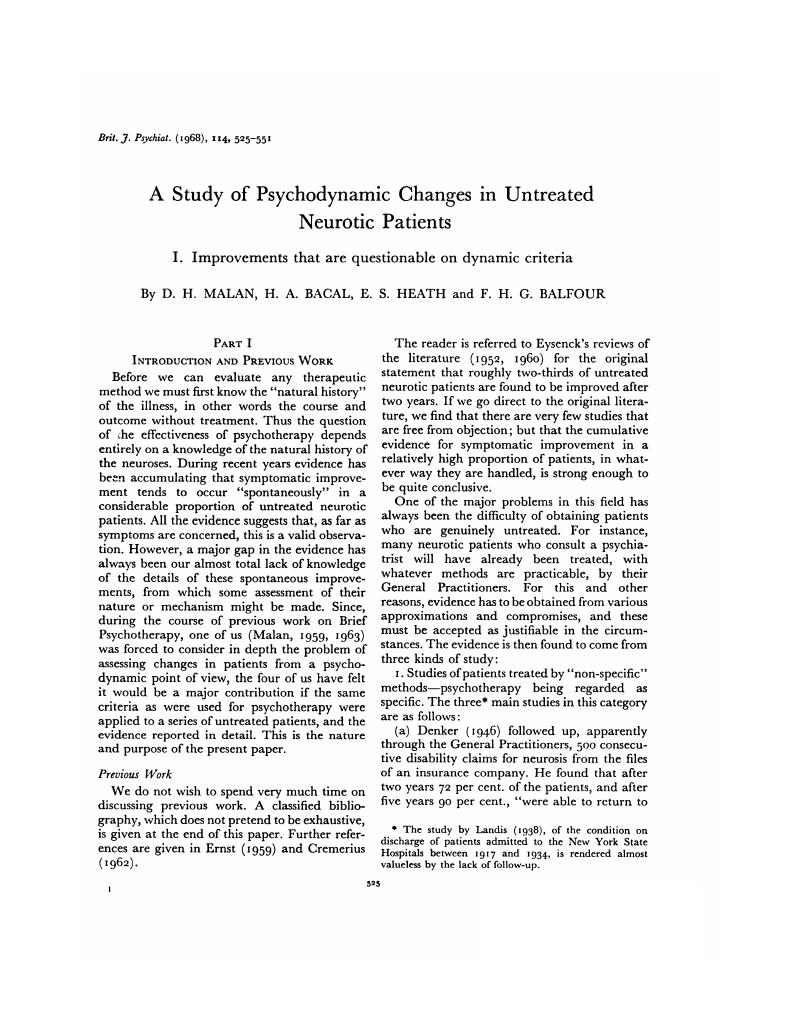Crossref Citations
This article has been cited by the following publications. This list is generated based on data provided by Crossref.
1969.
Book Review.
Journal of Asthma Research,
Vol. 7,
Issue. 2,
p.
105.
Eysenck, H.J.
1970.
Behavior therapy and its critics.
Journal of Behavior Therapy and Experimental Psychiatry,
Vol. 1,
Issue. 1,
p.
5.
Kind, Hans
1972.
Klinische Psychiatrie I.
Vol. 2 / 1,
Issue. ,
p.
727.
Tyrer, Peter
Candy, Julian
and
Kelly, Desmond
1973.
A study of the clinical effects of phenelzine and placebo in the treatment of phobic anxiety.
Psychopharmacologia,
Vol. 32,
Issue. 3,
p.
237.
Sund, Arne
1973.
The Prognosis of Psychiatric Disorders in Young Norwegian Men.
British Journal of Psychiatry,
Vol. 122,
Issue. 567,
p.
125.
Sund, A.
1974.
PROGNOSTIC FACTORS IN THE NEUROTIC ILLNESS.
Acta Psychiatrica Scandinavica,
Vol. 50,
Issue. 1,
p.
90.
Sirois, François
1975.
The Natural History of Neuroses: Problems of Methods and Substance.
Canadian Psychiatric Association Journal,
Vol. 20,
Issue. 4,
p.
273.
Tyrer, Peter
and
Steinberg, Derek
1975.
Symptomatic Treatment of Agoraphobia and Social Phobias: A Follow-up Study.
British Journal of Psychiatry,
Vol. 127,
Issue. 2,
p.
163.
Tanner, Janis
Weissman, Myrna
and
Prusoff, Brigitte
1975.
Social adjustment and clinical relapse in depressed outpatients.
Comprehensive Psychiatry,
Vol. 16,
Issue. 6,
p.
547.
1976.
Humanism and Behaviorism.
p.
403.
Bloch, Sidney
Bond, Gary
Qualls, Brandon
Yalom, Irvin
and
Zimmerman, Erik
1977.
Outcome in Psychotherapy Evaluated by Independent Judges.
British Journal of Psychiatry,
Vol. 131,
Issue. 4,
p.
410.
Sims, Andrew
1977.
Prognosis in the neuroses.
The American Journal of Psychoanalysis,
Vol. 37,
Issue. 2,
p.
155.
Kinston, Warren
and
Bentovim, Arnon
1978.
BRIEF FOCAL FAMILY THERAPY WHEN THE CHILD IS THE REFERRED PATIENT–II. METHODOLOGY AND RESULTS.
Journal of Child Psychology and Psychiatry,
Vol. 19,
Issue. 2,
p.
119.
de la Torre, Jorge
1978.
Brief Encounters: General and Technical Psychoanalytic Considerations.
Psychiatry,
Vol. 41,
Issue. 2,
p.
184.
Crowe, Michael J.
1978.
Conjoint marital therapy: a controlled outcome study.
Psychological Medicine,
Vol. 8,
Issue. 4,
p.
623.
Sims, Andrew C. P.
1978.
Current Themes in Psychiatry 1.
p.
114.
Tyrer, P.J
and
Remington, Marina
1979.
CONTROLLED COMPARISON OF DAY-HOSPITAL AND OUTPATIENT TREATMENT FOR NEUROTIC DISORDERS.
The Lancet,
Vol. 313,
Issue. 8124,
p.
1014.
Remington, Marina
and
Tyrer, P.
1979.
The social functioning schedule ? A brief semi-structured interview.
Social Psychiatry,
Vol. 14,
Issue. 3,
p.
151.
Athey, George I.
and
Coyne, Lolafaye
1979.
Toward a Rapprochement of Empirical and Clinical Inquiry in Evaluation of Psychologically Oriented Alcoholism Treatment.
Alcoholism: Clinical and Experimental Research,
Vol. 3,
Issue. 4,
p.
341.
1980.
The Effects of Psychological Therapy.
p.
265.






eLetters
No eLetters have been published for this article.